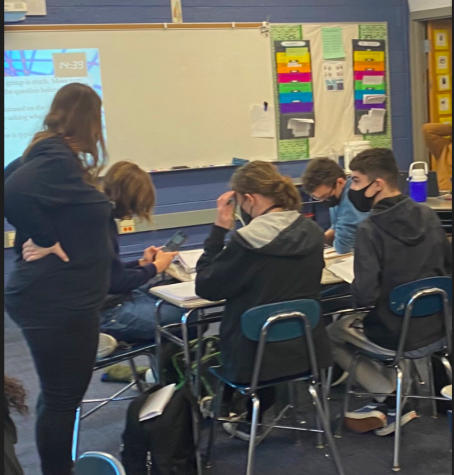The Precariousness of the New PreCalc Curriculum
Precalculus. The course is strictly there for one reason: to prepare. Who would have thought a class solely meant to get kids ready for Calculus could be so challenging. The topics in this class include factoring, graphing, exponents, logarithms, quadratics, functions, and much more. Different from previous years, this year, Berkley’s precalculus is under the CPM curriculum. CPM stands for College Preparatory Mathematics and is a book that we tend to follow here at Berkley. CPM basically is a set of pre-made math lessons which alleviates a lot of lesson planning for teachers. It was originally an Eisenhower-funded grant program. CPM teaching strategies focus on how students best learn and retain mathematics. Students have been finding this curriculum extremely challenging though and some have switched out of the class. BHS precalculus teacher Mrs. Sandtveit has shared her thoughts behind the course with The Spectator.
“What we’re teaching this year hasn’t changed from previous years, we’re just using a different resource, CPM, which is inquiry-based and student-centered, instead of teacher-centered,” explained Sandtveit. Sandtveit continues on to say that she really likes the CPM resource. “I love that students have the opportunity to make sense of concepts, instead of just listening to the teacher talk and take notes.” Sandtveit explains how studies show that actively learning the concepts in groups together, will be more effective and stay with students long term. She then explained how the class primarily works. “There is more emphasis on students working in groups to learn the concepts. CPM recommends using Group Roles, Task Manager, Facilitator, Reporter/Recorder, and Resource Manager to help the groups work effectively and efficiently. At the end of that process, Mrs. Blazic and I bring the big ideas together. CPM also designs their homework, so that students are constantly reviewing previous material, which helps it stay fresh.”
Because of last year’s hybrid schedule due to the pandemic, Sandtveit claims that it’s a little challenging to know whether students have learned something they were supposed to learn last year or not. “We had no control over what resources were used on assessments.” She also said, “For some students, math has always come easily to them and precalculus is the first time they really have to work to understand the material. This is always true of precalculus, whether or not we’re in a pandemic.” Sandtveit typically recommends students with a B+ or higher in Algebra 2 to take precalculus, but ultimately anyone who is up for the challenge should take it on.
Seniors Jordyn Wolf and Annabel Bean took precalculus last year and have shared their experience and thoughts. Wolf describes precalculus as a class where you study functions and make lots of graphs.
Bean adds on and says, “I think it prepared me for calculus because in calc we use a lot of the stuff we learned in pre calc as a foundation for harder problems, so you definitely need to understand those foundations in order to do well.”
Unlike Bean, Wolf took AP Statistics after precalculus. The two girls took the class over Zoom, which made it different for them. Wolf preferred it because it allowed her to use her notes and take tests in groups. Bean thought it was more difficult because she couldn’t focus as much.
“I think most of the content was pretty easy,” said Bean.

Students taking precalculus this year would disagree. This could be due to the curriculum change. This year, several students who started the year taking precalculus, ended up switching out, and into other math classes for the second semester.
“Precalculus this year was just too challenging and hurting my grades, so second semester I decided to switch out and take Trig and Stats with Mrs. Danaher,” said junior Ruby Katkowsky. Sharmel Gibson, a sophomore taking Pre Calc this year says, “Precalculus is a lot of group work.You learn things by doing problems with your table and then the teacher goes over them after. This can be challenging because it requires a lot of effort and brain power.” I asked the students what kinds of learners should take precalculus and here is what they said. “I recommend students that like graphing and are up for a challenge,” says Wolf. “I recommend students that can stay focused and pick up on different things quickly. They need to be up for a challenge and be able to learn things on their own with their group,” explains Gibson.
Precalculus is one math that students have a lot of mixed feelings about. Whether it’s just too hard or the perfect balance of challenging and easy, each student has their own opinion on the class. If you are in Algebra 2 and are considering taking precalculus next year, hopefully this helps guide you in the right direction for you.

I am a sophomore and the feature editor this year. I enjoy writing entertainment articles the best. I love journalism because of the writing freedom we...

I am a sophomore and the feature editor this year. I enjoy writing entertainment articles the best. I love journalism because of the writing freedom we...







